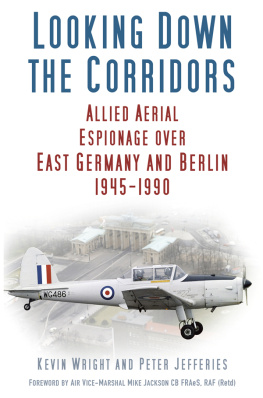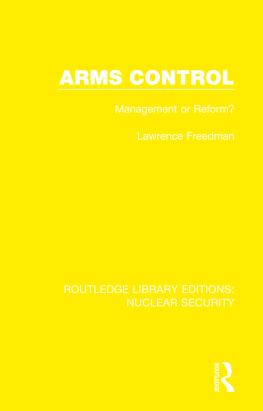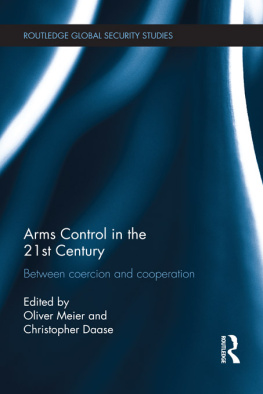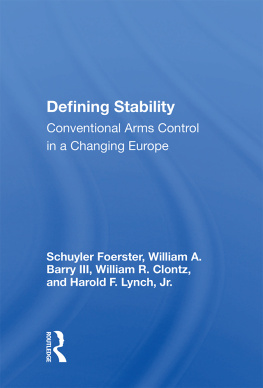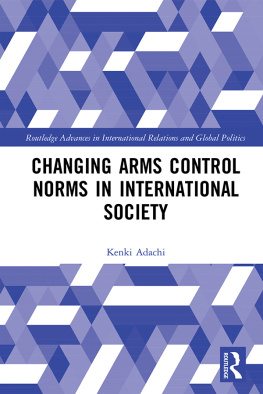ARMS CONTROL AND SECURITY
For Sue and Stefan
Arms Control and Security
The changing role of conventional arms control in Europe
KEVIN WRIGHT
University of Essex
First published 2000 by Ashgate Publishing
Reissued 2018 by Routledge
2 Park Square, Milton Park, Abingdon, Oxon, OX14 4RN
711 Third Avenue, New York, NY 10017, USA
Routledge is an imprint of the Taylor & Francis Group, an informa business
Copyright Kevin Wright 2000
All rights reserved. No part of this book may be reprinted or reproduced or utilised in any form or by any electronic, mechanical, or other means, now known or hereafter invented, including photocopying and recording, or in any information storage or retrieval system, without permission in writing from the publishers.
Notice:
Product or corporate names may be trademarks or registered trademarks, and are used only for identification and explanation without intent to infringe.
Publishers Note
The publisher has gone to great lengths to ensure the quality of this reprint but points out that some imperfections in the original copies may be apparent.
Disclaimer
The publisher has made every effort to trace copyright holders and welcomes correspondence from those they have been unable to contact.
A Library of Congress record exists under LC control number: 00132796
ISBN 13: 978-1-138-72518-8 (hbk)
ISBN 13: 978-1-315-19202-4 (ebk)
Contents
Kevin Wright, is a Teaching Fellow in the Department of Government at the University of Essex. He teaches primarily in the field of international relations and on the European Union. He works and writes extensively on conventional arms control issues, the European security architecture and the emerging security threats facing the North Atlantic area.
The conclusion of the Conventional Armed Forces in Europe Treaty in 1990, the series of Vienna Documents from 1990 onwards and the Treaty on Open Skies in 1992 were agreements, along with those applying to nuclear weapons, which were intended to enable Europe to look forward to a future overshadowed less by military affairs than had been possible for the previous fifty years.
The reality however has been far from this expectation. Wars of succession have taken place in the former Yugoslavia and on the territory of the former Soviet Union, whilst ethnic tensions have grown in other parts of Central and Eastern Europe too. At the same time the old alliance structure has collapsed with the dissolution of the Warsaw Treaty Organisation and a NATO scrambling to reinvent itself in a radically different security environment. NATO forces have been actively engaged militarily in the Balkans in a role very different from that envisaged during the Cold War for Alliance forces.
In all of this melee arms control and confidence building has taken on an increasingly lower priority, indeed the approach taken during the Cold War, often look increasingly outdated, if not entirely obsolete. Yet at the same time the continuing military contacts required and fostered by the major arms control agreements of the 1990s still has a value.
The aim of this book is to explore the changing role of conventional arms control in Europe. The early chapters provide a primarily historical perspective looking at the context, foundations, main provisions and institutional structure of the main agreements. The later chapters explore the continuing and likely future roles of the OSCE and NATO in the arms control process. The final chapters examine more contemporary developments by looking at the Adapted CFE Treaty and Vienna Documents agreed at the OSCE Istanbul Summit in November 1998 and the challenges posed to existing arrangements by the changing and emergent security threats that potentially face Europe.
Throughout the book in undertaking the examination of this important area of security policy I have adopted an epistemic community/network approach. As is explained in this methodology, though it is incomplete and has weaknesses, provides a useful way of understanding the advances and developments made in the mid-nineteen eighties and why progress has become more difficult since.
In putting together this work of necessity I have received a great deal of assistance from officials within NATO, the OSCE Secretariat, the United Kingdom Ministry of Defence and the UK Delegation to the OSCE in Vienna. My thanks to all of those concerned. Most important of all however are 2 further people: Professor Emil Kirchner and Lynda Hudson both at the University of Essex. Professor Kirchner for getting me started on this project in the first place and providing much advice and assistance well beyond the call of duty. My thanks to Lynda are for her preparedness to read the many drafts of chapters and correcting the large number of my mistakes, normally at times when she had much better things to do.
Any mistakes or omissions are, of course, entirely my own responsibility.
Kevin Wright
University of Essex
ACDA | Arms Control & Disarmament Agency (US) |
ACDU | Arms Control & Disarmament Research Unit (FCO) |
ACFE | Adapted CFE Treaty |
ACV | Armoured Combat Vehicle |
ACVC | Arms Control Verification Centre |
AIAM | Annual Implementation Assessment Meeting |
AIFV | Armoured Infantry Fighting Vehicle |
APC | Armoured Personnel Carrier |
ATTU | Atlantic to the Urals |
BWC | Biological Weapons Convention |
CBM | Confidence Building Measure |
CDE | Conference on Disarmament in Europe |
CEE | Central & Eastern Europe |
CFE | Conventional Forces in Europe |
CFE 1A | Concluding Act of the Negotiation on Personnel Strength of Conventional Armed Forces in Europe |
CFSP | Common Foreign & Security Policy (EU) |
CiO | Chairman in Office (OSCE) |
CIS | Commonwealth of Independent States |
CPC | Conflict Prevention Centre |
CSBM | Confidence Security Building Measures |
CSCE | Conference on Security Co-operation in Europe |
CSO | Committee of Senior Officials (OSCE) |
CWC | Chemical Weapons Convention |
DTRA | Defence Threat Reduction Agency |
EAPC | Euro-Atlantic Partnership Council |
EU | European Union |
FCO | Foreign & Commonwealth Office |
FSC |


